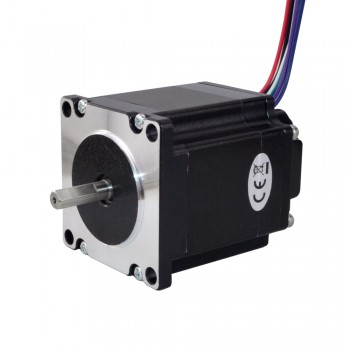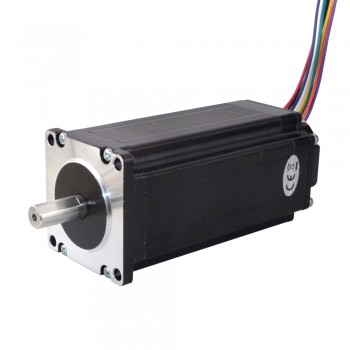1.Brief description of integrated stepper motor
An integrated stepper motor is a motor system that integrates stepper motor, driver, motion controller and encoder into a whole. This design greatly reduces the installation space and wiring requirements, improves the reliability and practicality of the system, and is particularly suitable for application scenarios with limited installation space and high integration requirements. The basic structure of an integrated stepper motor includes a stator and a rotor. The stator usually contains multiple electromagnetic coils, while the rotor consists of a series of magnetic poles. In addition, the integrated stepper motor also integrates the driver and controller, and sometimes also includes an encoder to form a closed-loop control system, ensuring higher accuracy and stability.

2.Working principle of integrated stepper motor
The working principle of integrated stepper motor is based on the control of electrical pulse signals. When current flows through the stator winding, the stator winding will generate a vector magnetic field, which will drive the rotor to rotate an angle so that the direction of a pair of magnetic fields of the rotor is consistent with the direction of the magnetic field of the stator. Each time an electrical pulse is input, the motor rotates a fixed angle, called the "step angle". By controlling the number of pulses, frequency and the power-on sequence of each phase winding of the motor, the rotation of the motor can be precisely controlled.
3.Driving mode of integrated stepper motor
1.Constant voltage drive: In this driving mode, the motor winding is powered by only one direction voltage during operation. When the input signal is high, the power supply voltage acts on the motor winding; when the signal is low, no current passes through the winding. The advantages of this driving mode are simple circuit structure, few components, low cost, and high reliability, but low efficiency, and it is only suitable for driving low-power stepper motors.
2.High and low voltage drive: In order to make the winding quickly reach the set current when powered on, and the winding current quickly decays to zero when turned off, and at the same time have high efficiency, a high and low voltage drive mode has emerged. High voltage is used to supply power at the front edge of conduction to increase the current rise rate, and low voltage is used to maintain the winding current in the subsequent period. This driving mode can obtain better high-frequency characteristics, but the control circuit is more complicated and the reliability is reduced. Once the high-voltage tube is out of control, the motor may be damaged.
3.Constant current chopper drive: This drive mode converts the current value of the stepper motor winding into a certain proportion of voltage, compares it with the preset value, and controls the current by chopping. The advantage of this drive mode is that it can accurately control the current and is suitable for occasions where precise torque control is required.

4.Characteristics and advantages of integrated stepper motors
1.Integrated design: The integrated stepper motor integrates the driver and the motor body, reduces external equipment and wiring, reduces the complexity and failure rate of the system, and improves the reliability of the system.
2.High-performance control: The closed-loop control technology is adopted to achieve precise control of the motor through real-time feedback of the motor's position and speed information, thereby improving the stability and accuracy of the system.
3.High-efficiency conversion: The design of the motor and the driver is optimized, the power conversion efficiency is improved, the energy consumption is reduced, and it meets the requirements of green environmental protection.
4.Intelligent operation: Supports a variety of control protocols and interface standards, and can achieve seamless connection with host computers or PLCs and other devices, facilitating users to conduct remote monitoring and debugging.
5.Small size: Integrated motors integrate multiple components together, reducing the overall volume, saving space, and are suitable for space-constrained applications.
6.High performance: The motor, control circuit, sensor and other components in the integrated motor can be tightly integrated and coordinated, thereby improving the overall performance of the system.
7.Simplified design and installation: The integrated design makes the design and installation of the system simpler, reduces wiring and connection work, and reduces the complexity of design and installation.
8.Improve reliability: Due to the reduction in the use of connectors, wiring and sensors, the risk of failure is reduced and the reliability of the system is improved.
9.Save energy: Integrated motors are generally more efficient, can more effectively convert electrical energy into mechanical energy, and reduce energy consumption.
Source:https://community.networkofcare.org/blogs/stepper_motor1/archive/2024/10/11/working-principle-and-driving-mode-of-integrated-stepper-motor.aspx








